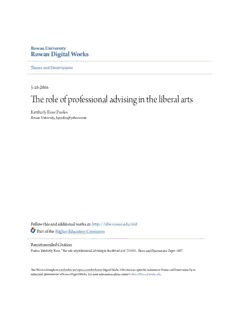
The role of professional advising in the liberal arts PDF
Preview The role of professional advising in the liberal arts
RRoowwaann UUnniivveerrssiittyy RRoowwaann DDiiggiittaall WWoorrkkss Theses and Dissertations 5-10-2016 TThhee rroollee ooff pprrooffeessssiioonnaall aaddvviissiinngg iinn tthhee lliibbeerraall aarrttss Kimberly Rose Poolos Rowan University Follow this and additional works at: https://rdw.rowan.edu/etd Part of the Higher Education Commons RReeccoommmmeennddeedd CCiittaattiioonn Poolos, Kimberly Rose, "The role of professional advising in the liberal arts" (2016). Theses and Dissertations. 1407. https://rdw.rowan.edu/etd/1407 This Thesis is brought to you for free and open access by Rowan Digital Works. It has been accepted for inclusion in Theses and Dissertations by an authorized administrator of Rowan Digital Works. For more information, please contact [email protected]. THE ROLE OF PROFESSIONAL ADVISING IN THE LIBERAL ARTS by Kimberly R. Poolos A Thesis Submitted to the Department of Educational Services and Leadership College of Education In partial fulfillment of the requirement For the degree of Master of Arts in Higher Education at Rowan University April 21, 2016 Thesis Chair: Burton R. Sisco, Ed.D. © 2016 Kimberly Rose Poolos Dedication This thesis is dedicated to all the wonderful people who work in higher education. Acknowledgments A lot of people have made this thesis possible for me to complete. First, I want to thank my Rowan University family whom I am lucky enough to call my mentors and friends. Christine Larsen-Britt, Dr. Cindy Vitto, Michael Schillo, Dr. Marci Carrasquillo, Dr. Kristen diNovi, Dr. Lee Talley and Robert Bullard. Without their continued support, help and advice this thesis would not have been possible. Additionally, I want to thank Dr. Burton Sisco. It is only thanks to his patience, persistence, and great knowledge that I was able to translate my ideas into action. I could not imagine a better person to be my coach and cheerleader through this process. I also want to thank my supportive family and boyfriend, Norman Gibson. Without their constant care and reassurance, I am not sure that I would have survived this journey. iv Abstract Kimberly Poolos THE ROLE OF PROFESSIONAL ADVISING IN THE LIBERAL ARTS 2015-2016 Burton R. Sisco, Ed.D. Master of Arts in Higher Education The purpose of this study was to investigate the role of professional academic advising in the liberal arts. This study focused on the impact of professional academic advising in the liberal arts. This study also focused on the extent to which professional administrators are involved in supporting the professional academic advisors. This was a Total Population Study since all five College of Humanities and Social Sciences embedded advisors participated in this study and the four administrators participated in this study. Qualitative research, through the use of 30 minute individual interviews, was used to collect data. Interview questions focused on demographic information, advising role, advising skills and education, post-graduation options, degree value, and any suggested changes. The research questions presented in Chapter I of this study were used to inform and develop the interview questions. Qualitative content analysis techniques, per Sisco (1981), were used in order to classify and categorize themes. Themes were presented through tables and illustrative quotes. The major finding of this study is just how critical experiential learning is to the success of Liberal Arts students. Additionally, professional academic advisors are critical in linking Liberal Arts students to these opportunities. v Table of Contents Abstract ............................................................................................................................v List of Tables ...................................................................................................................ix Chapter I: Introduction .....................................................................................................1 Statement of the Problem ...........................................................................................1 Purpose of the Study ..................................................................................................2 Significance of the Study ...........................................................................................2 Assumption and Limitations ......................................................................................3 Operational Definitions ..............................................................................................3 Research Questions ....................................................................................................5 Overview of the Study ...............................................................................................5 Chapter II: Review of the Literature ................................................................................7 The Liberal Arts: Foundations, Colleges, and Studies ..............................................8 Foundations of a Liberal Arts Education .............................................................8 From Liberal Arts Institutions to Liberal Arts Studies ........................................9 History of Academic Advising ..................................................................................10 Defining Academic Advising ..............................................................................11 Three Academic Advising Eras ...........................................................................11 Types of Academic Advising Models..................................................................13 Looking Toward the Future .................................................................................14 Theoretical Framework ..............................................................................................14 Student Development and Involvement ...............................................................15 Experiential Learning...........................................................................................17 vi Table of Contents (Continued) Academic Advising ..............................................................................................18 Role of Academic Advisors in Guiding Students ......................................................20 Showing Value in the Liberal Arts: Connecting the Liberal Arts to Career Paths ....22 Valuing a Liberal Arts Degree .............................................................................22 Career Paths in the Liberal Arts ...........................................................................23 Summary of the Literature Review ............................................................................25 Chapter III: Methodology ................................................................................................27 Context of the Study ..................................................................................................27 Population and Sample Selection...............................................................................30 Instrumentation ..........................................................................................................31 Data Collection ..........................................................................................................31 Data Analysis .............................................................................................................32 Chapter IV: Findings........................................................................................................33 Profile of the Study Participants ................................................................................33 Analysis of the Data ...................................................................................................35 Research Question 1 ............................................................................................35 Research Question 2 ............................................................................................40 Research Question 3 ............................................................................................50 Research Question 4 ............................................................................................58 Chapter V: Summary, Discussion, Conclusions, and Recommendations .......................63 Summary of the Study ...............................................................................................63 Discussion of the Findings .........................................................................................64 vii Table of Contents (Continued) Research Question 1 ............................................................................................64 Research Question 2 ............................................................................................66 Research Question 3 ............................................................................................69 Research Question 4 ............................................................................................72 Conclusions ................................................................................................................73 Recommendations for Practice ..................................................................................76 Recommendations for Further Research ....................................................................77 References ........................................................................................................................80 Appendix A: Institutional Review Board Approval ........................................................83 Appendix B: Permissions to Conduct Research ..............................................................86 Appendix C: Recruitment Email ......................................................................................88 Appendix D: Consent Forms ...........................................................................................89 Appendix E: Interview Protocol ......................................................................................92 viii List of Tables Table Page Table 4.1. Study Participants Profile ...............................................................................35 Table 4.2. Content Analysis Results for Skills/Knowledge Required to be a CHSS Academic Advisor ...........................................................................................................37 Table 4.3. Content Analysis Results for the Payoff/Value of a CHSS degree ................41 Table 4.4. Content Analysis Results for Employment Opportunities for CHSS Students ..........................................................................................................................................43 Table 4.5. Content Analysis Results for Ways to Combat the Decline and Devaluing of Liberal Arts ......................................................................................................................45 Table 4.6. Content Analysis Results for Changes to Help CHSS Students Secure Employment .....................................................................................................................48 Table 4.7. Content Analysis Results for Perceived Role of Professional Academic Advisors ...........................................................................................................................51 Table 4.8. Content Analysis Results for Identifying and Seeking CHSS Employment Opportunities....................................................................................................................54 Table 4.9. Content Analysis Results for Graduate Opportunities for CHSS Students ....57 Table 4.10. Content Analysis Results for Impact of CHSS Embedded Advising on CHSS Students ............................................................................................................................60 ix
Description: